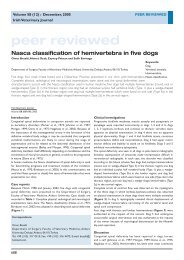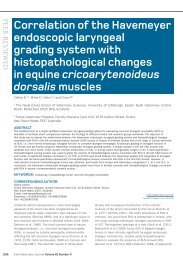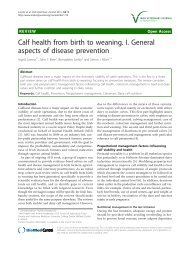peer reviewed - Irish Veterinary Journal
peer reviewed - Irish Veterinary Journal
peer reviewed - Irish Veterinary Journal
You also want an ePaper? Increase the reach of your titles
YUMPU automatically turns print PDFs into web optimized ePapers that Google loves.
Volume 57 (1) : January, 2004<br />
<strong>Irish</strong> <strong>Veterinary</strong> <strong>Journal</strong><br />
<strong>peer</strong> <strong>reviewed</strong><br />
or recurrent otitis externa. End-stage otitis externa was defined<br />
as chronic otitis externa with marked stenosis and/or<br />
calcification of the horizontal ear canal, as determined by<br />
otoscopic examination and skull radiography. A tentative<br />
diagnosis of otitis media was made if the tympanic membrane<br />
was perforated or absent on otoscopic examination or if there<br />
was evidence of radiological changes within the bulla. Otitis<br />
media was confirmed on surgical exploration of the bulla.<br />
All surgical procedures were performed under general<br />
anaesthesia using a standard surgical technique (Krahwinkel,<br />
1993) by staff surgeons or by surgical residents. Post-operative<br />
analgesia was provided using a combination of opioids, nonsteroidal<br />
anti-inflammatory drugs and bupivicaine ‘splash block’<br />
(Buback et al., 1996). Post-operative complications were<br />
defined as those occurring up to four months after surgery.<br />
Results of treatment were obtained by either physical<br />
examination of the dogs or telephone follow-up four months or<br />
more after surgery.<br />
For LECR and VECA, the results of surgery were evaluated,<br />
using the criteria of Gregory and Vasseur (1983), as either:<br />
• excellent – clinical signs were resolved with minimal or no<br />
care required by the owner;<br />
• improved – occasional recurrence of clinical signs requiring<br />
professional attention;<br />
• poor – no improvement.<br />
For the TECA/LBO procedures, results were evaluated, using<br />
the criteria of Mason et al. (1988), as either:<br />
• excellent – resolution of clinical signs of ear disease without<br />
long-term complication;<br />
• improved – improvement of clinical signs after surgery but<br />
continued disease of the remaining medial wall of the pinna<br />
requiring treatment, or facial nerve paralysis not requiring<br />
treatment;<br />
• poor – continuing ear canal or middle ear disease present, or<br />
permanent facial nerve paralysis requiring continued medical<br />
treatment.<br />
FIGURE 3: Postoperative<br />
failed<br />
lateral ear canal<br />
resection. Arrow<br />
indicates the<br />
hyperplastic medial<br />
wall. Arrowhead<br />
indicates occluded<br />
horizontal ear canal.<br />
Results<br />
The duration of ear disease ranged from one to 84 months, with<br />
a median of 12 months. Previous medical treatments such as<br />
topical and systemic antibiotics and corticosteroids had been<br />
used in all cases. Nineteen dogs had dermatological lesions not<br />
involving the ears: disorders of keratinisation (‘seborrhoea’) in<br />
three dogs, pyoderma in two dogs, confirmed atopy in one dog<br />
and suspected hypersensitivity skin disease (atopy, food allergy,<br />
flea-bite allergic dermatitis, contact allergic dermatitis) in 13<br />
dogs. A decision on the appropriate surgical management for<br />
each case was made based on the clinical evaluation of the<br />
extent of the ear disease and after discussion with the owner.<br />
Thirteen ears were treated with LECR (Table 2): one ear in<br />
each of five dogs and both ears in four dogs. One dog (Case no.<br />
9, Table 2) had concurrent bilateral otitis media, which was<br />
responding to medical treatment at the time of surgery. Followup<br />
results were obtained in eight dogs from four to 50 months<br />
after surgery. Results were excellent in one dog, improved in<br />
two dogs, and poor in five dogs. An excellent result did not<br />
occur in any dog that had concurrent dermatological lesions.<br />
Two of the dogs that had a poor result following LECR (Case<br />
nos. 2 and 8; Table 2) subsequently had TECA/LBO surgery<br />
on the affected ear.<br />
One dog, which had chronic otitis externa with ulceration of<br />
the medial wall of the vertical ear canal, was treated with VECA.<br />
Results were excellent in this dog. VECA is rarely indicated<br />
because irreversible epithelial changes in chronic otitis externa<br />
are rarely confined to the vertical ear canal.<br />
TECA/LBO was performed in 37 dogs (47 ears); ten dogs had<br />
bilateral TECA/LBO. All these dogs had chronic otitis externa,<br />
except for one, which presented with para-aural fistulation as a<br />
complication of previous TECA without LBO for chronic otitis<br />
externa (Case no. 41, Table 2). Prior to TECA/LBO, twelve<br />
dogs (14 ears) had undergone previous surgical treatment for<br />
chronic otitis externa: LECR (Figure 3) in 11 ears (two of<br />
which are reported above: Case nos. 2 and 8; Table 2); VECA<br />
in two ears; and TECA in one ear.<br />
Chronic otitis externa had progressed to end-stage otitis externa<br />
characterised by irreversible narrowing of the horizontal ear<br />
canal in 41 of 47 ears. Otitis media was present in 32 of 47 ears,<br />
diagnosed either before TECA/LBO surgery or confirmed at<br />
the time of surgery. One dog had sustained a traumatic ear<br />
canal separation, which led to chronic otitis externa and otitis<br />
media (Case no. 41, previously reported in Connery et al.,<br />
2001).<br />
Pre-operative skull radiography had permitted evaluation of 27<br />
of the 32 ears with otitis media. However, nine of 27 ears were<br />
negative radiographically for otitis media, representing a false-<br />
24







